During AGU’s 2021 Fall Meeting in New Orleans, we were honored to meet many community members who are working to make the region’s neighborhoods healthier, more connected and more resilient. Here’s a glimpse of what we saw.
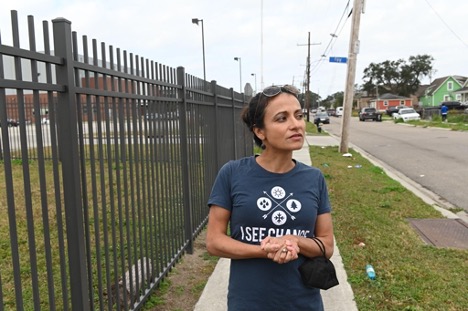 Community lead Julia Kumari Drapkin stands in front of a football field in Gentilly, now the site of a water retention project. The community-sourced data from the Gentilly Thriving Earth Exchange project was a catalyst that resulted in remodeling and reallocation of $4.8 million in flood mitigation to the St. Bernard Campus in Gentilly. The underground unit was expanded by 2.5x, storing up to 5 million gallons of stormwater in underground detention basins – the largest of its kind in the South.
Community lead Julia Kumari Drapkin stands in front of a football field in Gentilly, now the site of a water retention project. The community-sourced data from the Gentilly Thriving Earth Exchange project was a catalyst that resulted in remodeling and reallocation of $4.8 million in flood mitigation to the St. Bernard Campus in Gentilly. The underground unit was expanded by 2.5x, storing up to 5 million gallons of stormwater in underground detention basins – the largest of its kind in the South.
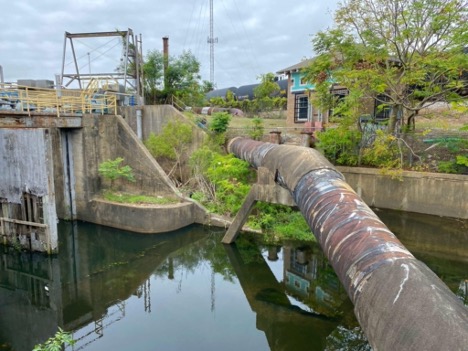 A view of Pumping Station No. 3 in the 7th Ward. Flood control infrastructure is critical in New Orleans 24/7 – there’s someone on the job at every pumping station in the city at all hours, every day, 365 days a year. Here, we see the canal and the transfer pipe that moves water out of the neighborhood and pumps it to Lake Pontchartrain.
A view of Pumping Station No. 3 in the 7th Ward. Flood control infrastructure is critical in New Orleans 24/7 – there’s someone on the job at every pumping station in the city at all hours, every day, 365 days a year. Here, we see the canal and the transfer pipe that moves water out of the neighborhood and pumps it to Lake Pontchartrain.
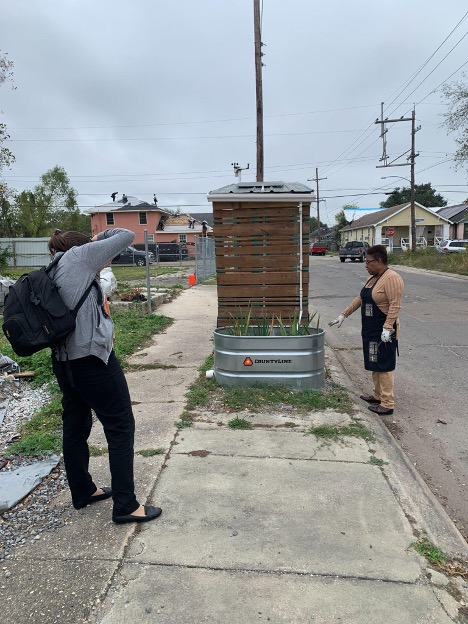 AGU Design director Beth Bagley photographs Angela Chalk, founder of Healthy Community Services, in front of a bus shelter designed with a slanted roof and rain garden to reduce flooding. It also includes a solar-powered charging station that residents can use to power up electronics – a valuable resource if power is lost due to hurricanes or other climate catastrophes. Angela Chalk served as community lead on a Thriving Earth project on monitoring the effects of greening on the urban heat island effect, water uptake, and social challenges and is serving as a Community Science Fellow on a new project in the 7th Ward.
AGU Design director Beth Bagley photographs Angela Chalk, founder of Healthy Community Services, in front of a bus shelter designed with a slanted roof and rain garden to reduce flooding. It also includes a solar-powered charging station that residents can use to power up electronics – a valuable resource if power is lost due to hurricanes or other climate catastrophes. Angela Chalk served as community lead on a Thriving Earth project on monitoring the effects of greening on the urban heat island effect, water uptake, and social challenges and is serving as a Community Science Fellow on a new project in the 7th Ward.
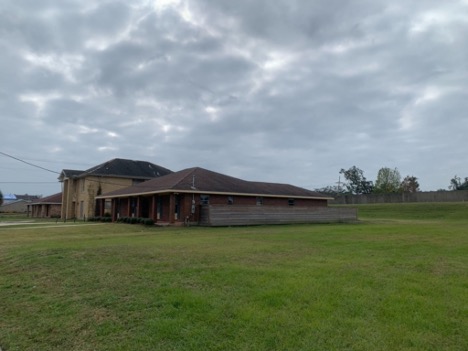 The Flooded House Museum at the breach site of the London Avenue Canal flood wall is a sobering reminder of the impacts of Hurricane Katrina. During the storm, the house was pushed across the street and turned around 180 degrees. Today, it has been returned to its original plot, and is preserved as a museum where visitors can look in through storm windows to see how the hurricane devastated its interior. The London Avenue Canal’s flood wall can be seen in the background; the wall was breached just yards from where the house stood.
The Flooded House Museum at the breach site of the London Avenue Canal flood wall is a sobering reminder of the impacts of Hurricane Katrina. During the storm, the house was pushed across the street and turned around 180 degrees. Today, it has been returned to its original plot, and is preserved as a museum where visitors can look in through storm windows to see how the hurricane devastated its interior. The London Avenue Canal’s flood wall can be seen in the background; the wall was breached just yards from where the house stood.
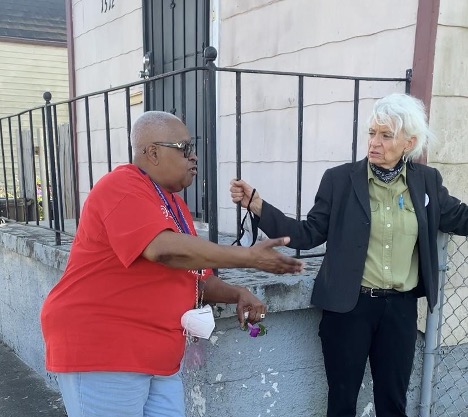 Community lead Beth Butler and resident Debra Campbell stand at the corner at the site of a future bioswale and affordable housing in New Orleans’ 8th Ward. The planned design integrates native plant gardens and private outdoor space to promote residents’ physical and mental health as part of the Thriving Earth projects Designing Bioswales for Improved Air Quality, Serenity and Reduced Flood Risk and Assessing Flooding and Hydrodynamics for Community Revitalization.
Community lead Beth Butler and resident Debra Campbell stand at the corner at the site of a future bioswale and affordable housing in New Orleans’ 8th Ward. The planned design integrates native plant gardens and private outdoor space to promote residents’ physical and mental health as part of the Thriving Earth projects Designing Bioswales for Improved Air Quality, Serenity and Reduced Flood Risk and Assessing Flooding and Hydrodynamics for Community Revitalization.
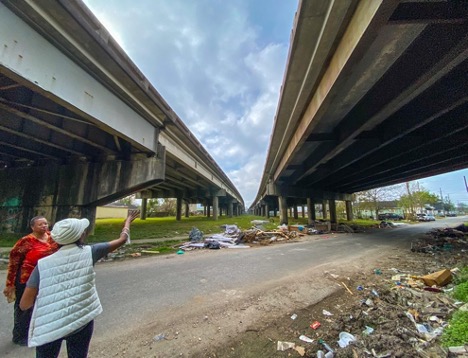 Community leads Amy Stelly and Tamah Yisrael pointing out the I-10 corridor in the 7th Ward, New Orleans. Their organization, Claiborne Avenue Alliance, worked with Thriving Earth Exchange to evaluate the impacts of Highway I-10 that runs above Claiborne Avenue. Their work contributed to a national conversation with New Orleans at its center.
Community leads Amy Stelly and Tamah Yisrael pointing out the I-10 corridor in the 7th Ward, New Orleans. Their organization, Claiborne Avenue Alliance, worked with Thriving Earth Exchange to evaluate the impacts of Highway I-10 that runs above Claiborne Avenue. Their work contributed to a national conversation with New Orleans at its center.
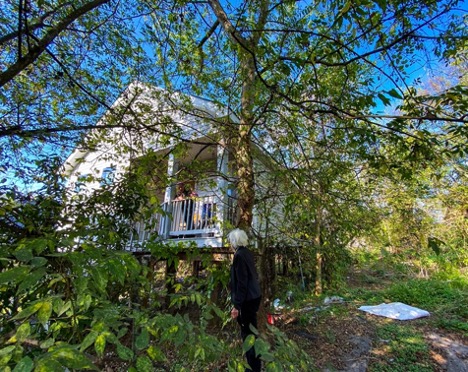 Visiting flood-affected homes in the 9th Ward, New Orleans, with community lead Beth Butler. Raising homes on stilts like this protects them from floods; the lot next door will be developed into a rain garden and bioswale to provide further flood protections and beautify the neighborhood.
Visiting flood-affected homes in the 9th Ward, New Orleans, with community lead Beth Butler. Raising homes on stilts like this protects them from floods; the lot next door will be developed into a rain garden and bioswale to provide further flood protections and beautify the neighborhood.
